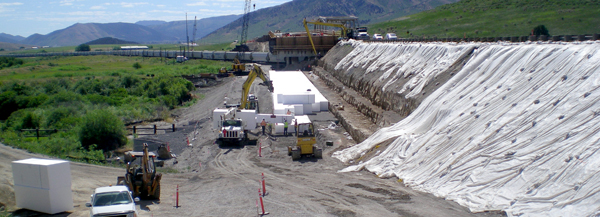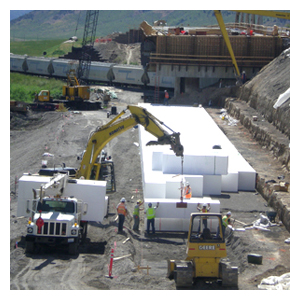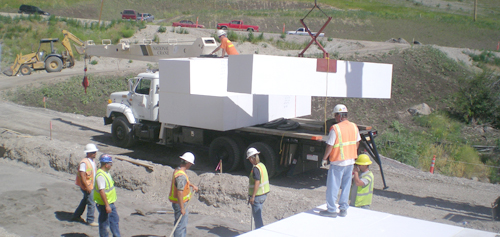

Bridge project using unique fill product – high-density foam
High-density foam products such as those used as fast-food drink containers and insulated coolers often are considered a threat to the environment. They have a long lifespan, are not biodegradable and clog landfills.
But those same characteristics make high-density foam an appropriate material for some highway construction applications, as ITD is proving in southeast Idaho.
 Construction of a new Topaz Bridge over the Union Pacific Railroad and Portneuf Marsh Valley Canal east of McCammon incorporates large foam blocks as fill material for the bridge approaches, explains Joe Pihlaja, an engineer with District 5.
Construction of a new Topaz Bridge over the Union Pacific Railroad and Portneuf Marsh Valley Canal east of McCammon incorporates large foam blocks as fill material for the bridge approaches, explains Joe Pihlaja, an engineer with District 5.
Soil under the west approach is unstable because of high water content. Weight from conventional construction would make the fill susceptible to settlement and compromise the highway.
So engineers turned to high-density foam, called Expanded Polystyrene (EPS) or Geofoam,” as an alternative – the first such application in Idaho. The Utah Department of Transportation used a similar approach on an Interstate 15 project before the 2002 Olympics.
As the four-lane bridge takes shape nearby, subcontractor Scarsella Brothers of Seattle began placing high-density foam blocks as a lightweight fill for the west bridge approach. Most blocks are about four feet wide, four feet high, seven to 14 feet long and weigh between 200 and 400 pounds. Conventional fill weighs about 100 times more, Pihlaja says.
An excavator with special tongs that grasp the blocks is used to move the blocks carefully into place, one at a time. Each layer is set like concrete pavers or Lego blocks.
To secure the growing structure, every other layer is placed perpendicular to the one below it, Pihlaja explains. Contractors use steel plates with teeth on both sides to help the blocks tie together. A Mechanical Stabilized Earth (MSE) wall – wire “cages” filled with gravel, is constructed on top of the lightweight fill to retain the roadway gravel and pavement. The exposed geofoam will be covered with shotcrete – “sprayed concrete” – before completion of the highway segment.
When the unorthodox fill is finished next month, it will be about 30 feet high, 500 feet long and contain the equivalent of 22,000 cubic yards of foam blocks.
The project receives about nine truckloads daily from manufacturer Insulfoam of Kent, Wash.
Work started on the bridge in 2009 and should be complete next year, Pihlaja said. The four-lane structure will be 613 feet long and include the state’s longest center span – 320 feet. The bridge is part of a U.S. 30 corridor project funded by GARVEE (Grant Anticipation Revenue Vehicle) bonds.
The corridor projects include reconstruction, realignment and expansion of U.S. 30 between McCammon and Lava Hot Springs and reconstruction of the Topaz and Portneuf River Bridges.


Published 9-3-2010